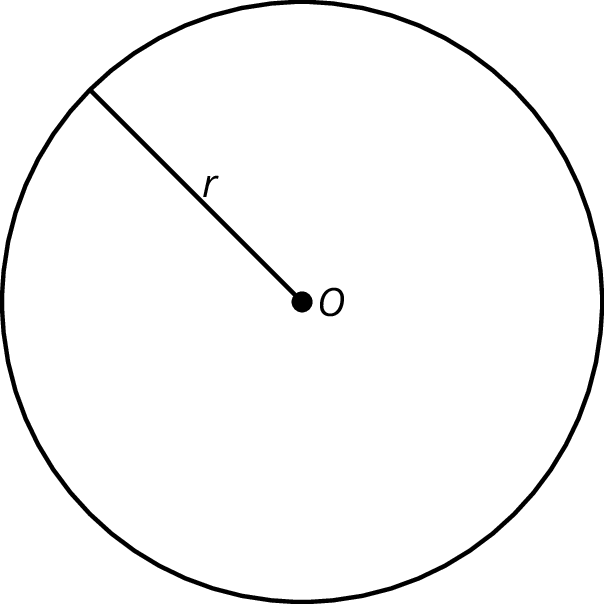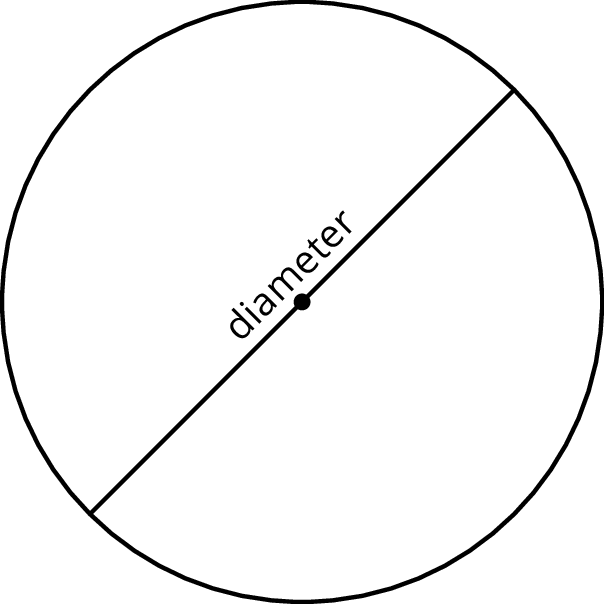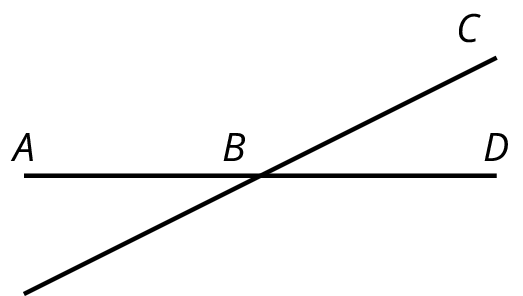A circle of radius $r$ with center $O$ is the set of all points that are a distance $r$ units from $O$.
To draw a circle of radius 3 and center $O$, use a compass to draw all the points at a distance 3 from $O$.
Two angles are adjacent if they share a side and a vertex, and they don't overlap.
The area of a circle whose radius is $r$ units is $\pi r^2$ square units.
A chance experiment is something you can do over and over again and you don't necessarily know what is going to happen each time. For example, tossing a coin is a chance experiment which could result in heads or tails.
A circle of radius $r$ with center $O$ is the set of all points that are a distance $r$ units from $O$.
To draw a circle of radius 3 and center $O$, use a compass to draw all the points at a distance 3 from $O$.

The circumference of a circle is the distance around the circle. If you imagine the circle as a piece of string, it is the length of the string. If the circle has radius $r$ then the circumference is $2\pi r$.
Two angles are complementary to each other if their measures add up to $90^\circ$. The two acute angles in a right triangle are complementary to each other.
See proportional relationship.
If a part of the original figure matches up with a part of the copy, we call them corresponding parts. The part could be an angle, point, or side, and you can have corresponding angles, corresponding points, or corresponding sides.
If you have a distance between two points in the original figure, then the distance between the corresponding points in the copy is called the corresponding distance.
A cross section is the two-dimensional figure that is exposed by slicing a three-dimensional object.
When you put money into a bank account, it is called making a deposit into the account, or depositing money in the account.
A line segment that has endpoints on a circle and passes through the center is called a diameter of the circle. The length of this segment is also called the diameter.

Two ratios $a:b$ and $c:d$ are equivalent ratios if there is a number $s$ that you can multiply both $a$ and $b$ by to get $c$ and $d$ (respectively). In other words, $a\boldcdot s = c$ and $b \boldcdot s = d$.
An event is a set of possible outcomes of a chance experiment. It could be just a single outcome, like heads when you toss a coin, or it could be a set of outcomes. For example, when you perform the chance experiment of tossing a coin twice, then "at least one head" is an event that includes the outcomes heads-tails, tails-heads, and heads-heads.
The interquartile range of a data set is a measure of spread of its distribution. It is the difference between the third quartile (Q3) and the first quartile (Q1).
The mean, or average, of a data set is the value you get by adding up all of the values in the set and dividing by the number of values in the set.
The mean absolute deviation measures the spread in a distribution. It is the mean of the distances of the data points from the mean of the distribution. (It is called mean absolute deviation because the distance of a data point from the mean is the absolute value of its deviation from the mean.)
Measurement error is the positive difference between a measurement of a quantity and the actual quantity. It is often expressed as a percentage of the actual value. For example, if we get 6 cm when we measure a line that is actually 6.2 cm long, then the measurement error is 0.2 cm and the percent error is 3.2%, because $0.2 \div 6.2=0.032$.
The median of a data set is the middle value when the data values are listed in order. If the number of values is even, it is the mean of the two middle values.
In the coordinate plane, the origin is the point $(0,0)$.
An outcome of a chance experiment is one of the things that can happen when you do the experiment. For example, the possible outcomes of tossing a coin are heads and tails.
The difference between the correct value and the incorrect value, expressed as a percentage of the correct value.
Given an initial amount, and a final amount which is smaller than the initial amount, the percentage decrease is the difference (initial amount minus final amount) expressed as a percentage of the initial amount.
Given an initial amount, and a final amount which is larger than the initial amount, the percentage increase is the difference (final amount minus initial amount) expressed as a percentage of the initial amount.
The Greek letter $\pi$ (pronounced "pie") stands for the number that is the constant of proportionality between the circumference of a circle and its diameter. If $d$ is the diameter and $C$ is the circumference, then $C = \pi d$.
A population is a set of people or things that we want to study.
The probability of an event is a number that measures how likely the event is to occur. It can be 0, 1, or any number in between. It is 0 if the event will never occur and 1 if the event always occurs. If an event occurs half the time in the long run then its probability is 0.5.
For a set of data, a proportion is a number from 0 to 1 that represents the fraction of the data that belongs to a given category.
If there is a positive constant $k$ so that the quantities $x$ and $y$ are related by the equation $y = kx$, then we say that $y$ and $x$ are in a proportional relationship, and that $y$ is proportional to $x$. The constant $k$ is called the constant of proportionality.
The distance from the center of a circle to any point on the circle. Also the corresponding line segment from the center to a point on the circle.
If all the outcomes of a chance experiment are equally likely, then we say the outcomes are random, or that they happen at random.
A repeating decimal is an infinite decimal expansion that eventually repeats the same sequence of digits over and over again. The repeated sequence is indicated by a line above it.
A sample that is representative of a population has a distribution that closely resembles the distribution of the population in shape, center, and spread.
When you divide a straight angle into two angles with equal measures, each of the two angles is a right angle. For example, the four corners of a square are right angles.
A sample is a subset of a population.
The sample space for a chance experiment is the list of all possible outcomes of the experiment. For example, the sample space for tossing a coin twice is heads-heads, heads-tails, tails-heads, and tails-tails.
See scale drawing.
A scale drawing of an object is a drawing in which all lengths in the drawing correspond to lengths in the object by the same scale. The scale tells you how the lengths correspond; for example, a scale of "1 inch to 2 feet" means that 1 inch in the drawing represents 2 feet in the object.
The scale factor is the factor by which every length in an original figure is increased or decreased when you make a scaled copy. For example, if you draw a copy of a figure in which every length is magnified by 2, then you have a scaled copy with a scale factor of 2.
A scaled copy of a figure is a figure in which every length in the original figure is increased or decreased by the same scale factor.
If the two rays that make an angle form a straight line, we call the angle a straight angle.
Two angles are supplementary to each other if their measures add up to $180^\circ$.
For example, angle $ABC$ is supplementary to angle $CBD$, because they add up to a straight angle, which has measure $180^\circ$.

A pair of vertical angles is a pair of angles that are across from each other at the point where two lines intersect. There are two pairs of vertical angles.

When you take money out of a bank account, it is called making a withdrawal from the account, or withdrawing money from the account.